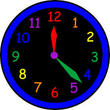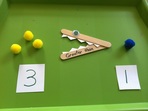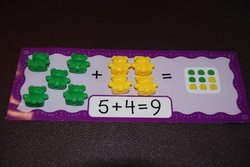Why is Subitizing so important?
|
There are a number of advantages involved for students who develop skills in Subitizing; such as saving time, developing more complex number and counting skills, as well as improving their ability to deal with more complex number problems into the future (Reys, et al., 2012). Listed below are some of the most important reasons for developing Subitizing in students.
|
What are the big ideas of Subitizing?

Perceptual vs conceptual Subitizing
Perceptual Subitizing
Closer to the basic definition of Subitizing, perceptual Subitizing involves identifying the number of a group, without counting or mathematical processes (Clements, 1999). Children are able to exhibit perceptual subitizing of numbers up to and including 4, without any previous knowledge of counting and without using mathematical processes (Charlesworth & Lind, 2013). As discussed in Clements, (1999) in some cases even infants can display elements of subitizing, by moving their eyes to the group of dots whose number corresponds to the number of beats heard by the child. This shows that although the infant has no previous mathematical skills or knowledge, is it possible for them to subitize small numbers.
Conceptual Subitizing
Conceptual Subitizing involves a different method, whereby the group is broken down into smaller parts of the whole, in order to be subitized more efficiently (Charlesworth & Lind, 2013). A student is able to conceptually subitize by searching for patterns within the group. Some of these patterns include larger spatial patterns such as those that can be found on dominoes, temporal and kinaesthetic, through use of finger patterns rhythm, and another is spatial-auditory (Clements, 1999). Conceptual Subitizing is also vital in the learning of arithmetic and subtraction, and those children who are not able to conceptually subitize may be at a disadvantage when they begin to learn these mathematical processes (Clements, 1999).
Patterns in Subitizing
When looking in particular at spatial arrangements of groups, research suggests that certain arrangements easier to subitize than others, not just for young children but for students from primary through college (Clements, 1999). They tended to find that rectangular arrangements were the easiest for students to subitize, followed with linear, circular and then random or scrambled arrangements being the hardest to subitize. While all larger groups are naturally harder to subitize, the rectangular arrangements are able to be easily broken up into smaller easily distinguishable groups, for example six dots as arranged to the right, can be easily broken into two groups of three.
Perceptual Subitizing
Closer to the basic definition of Subitizing, perceptual Subitizing involves identifying the number of a group, without counting or mathematical processes (Clements, 1999). Children are able to exhibit perceptual subitizing of numbers up to and including 4, without any previous knowledge of counting and without using mathematical processes (Charlesworth & Lind, 2013). As discussed in Clements, (1999) in some cases even infants can display elements of subitizing, by moving their eyes to the group of dots whose number corresponds to the number of beats heard by the child. This shows that although the infant has no previous mathematical skills or knowledge, is it possible for them to subitize small numbers.
Conceptual Subitizing
Conceptual Subitizing involves a different method, whereby the group is broken down into smaller parts of the whole, in order to be subitized more efficiently (Charlesworth & Lind, 2013). A student is able to conceptually subitize by searching for patterns within the group. Some of these patterns include larger spatial patterns such as those that can be found on dominoes, temporal and kinaesthetic, through use of finger patterns rhythm, and another is spatial-auditory (Clements, 1999). Conceptual Subitizing is also vital in the learning of arithmetic and subtraction, and those children who are not able to conceptually subitize may be at a disadvantage when they begin to learn these mathematical processes (Clements, 1999).
Patterns in Subitizing
When looking in particular at spatial arrangements of groups, research suggests that certain arrangements easier to subitize than others, not just for young children but for students from primary through college (Clements, 1999). They tended to find that rectangular arrangements were the easiest for students to subitize, followed with linear, circular and then random or scrambled arrangements being the hardest to subitize. While all larger groups are naturally harder to subitize, the rectangular arrangements are able to be easily broken up into smaller easily distinguishable groups, for example six dots as arranged to the right, can be easily broken into two groups of three.




